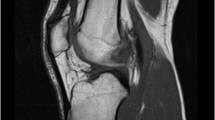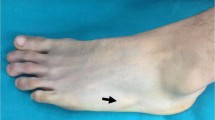Abstract
Purpose
Accessory ossicles are caused by the failure of the fusion of secondary ossification centres and are more likely to occur due to heavy loading during the growth period or improper treatment after injury. This study aimed to investigate the incidence of foot and ankle accessory ossicles in male professional soccer players.
Methods
This study included male professional soccer players who underwent medical checkups at our hospital between 2017 and 2023 as the soccer group. Medical checkups included radiographs of bilateral anteroposterior and oblique foot, as well as bilateral anteroposterior and lateral ankle. Male patients age-matched with the soccer group who visited our hospital undergoing anteroposterior and oblique foot or anteroposterior and lateral ankle radiography were included in the control group. The incidence of accessory ossicles was investigated and compared between the soccer and control groups.
Results
In this study, 276 ankles and 276 feet, as well as 121 ankles and 79 feet, were included in the soccer and control groups, respectively. The incidence of accessory ossicles in the soccer and control groups was as follows: accessory navicular 35.9%, 24% (P = .049), os peroneum 8.0%, 2.5% (P = .09); os supranaviculare 7.6%, 1.3% (P = .039); os infranaviculare 1.4%, 1.3% (P = .090); os calcaneus secundarius 4.3%, 0% (P = .059); os vesalianum 0%, 0%; os subfiblare 12.7%, 2.5% (P < .001); os subtibiale 18.1%, 2.5% (P = .001); and os trigonum 89%, 24% (P < .001).
Conclusions
Male professional soccer players had a higher incidence of accessory navicular, os supranaviculare, os subfiblare, os subtibiale, and os trigonum.







Similar content being viewed by others
Data Availability
The data and materials during the current study are available from the corresponding author on reasonable request.
References
Coskun N, Cevener MYM, Arican RY, Bircan HOO, Sindel T, Ilgi S, Sindel M (2009) Incidence of accessory ossicles and sesamoid bones in the feet: a radiographic study of the Turkish subjects. Surg Radiol Anat 31(1):19–24. https://doi.org/10.1007/s00276-008-0383-9
Gómez MPA, Aparisi F, Bartoloni A, Fons MAF, Battista G, Guglielmi G, Bazzocchi A (2019) Anatomical variation in the ankle and foot: from incidental finding to inductor of pathology. Part I: ankle and hindfoot. Insights Imaging 10(1):74. https://doi.org/10.1186/s13244-019-0746-2
Gómez MPA, Aparisi F, Bartoloni A, Fons MAF, Battista G, Guglielmi G, Bazzocchi A (2019) Anatomical variation in the ankle and foot: from incidental finding to inductor of pathology. Part II: midfoot and forefoot. Insights Imaging 10(1):69. https://doi.org/10.1186/s13244-019-0747-1
Kalbouneh H, Alajoulin O, Shawaqfeh J, Mustafa A, Jaber S, Zaben S, Zapen J, Alsalem M (2021) Accessory ossicles in the region of the foot and ankle: an epidemiologic survey in a Jordanian population. Medicina 57(11):1178. https://doi.org/10.3390/medicina57111178
Jegal H, Park YU, Kim JS, Choo HS, Seo YU, Lee KT (2016) Accessory navicular syndrome in athlete vs general population. Foot Ankle Int 37(8):862–867. https://doi.org/10.1177/1071100716644791
Karasick D (1994) Fractures and dislocations of the foot. Semin Roentgenol 29(2):152–175. https://doi.org/10.1016/s0037-198x(05)80062-8
Lee DJ, Shin HS, Lee JH, Kyung MG, Lee KM, Lee DY (2020) Morphological characteristics of os subfibulare related to failure of conservative treatment of chronic lateral ankle instability. Foot Ankle Int 41(2):216–222. https://doi.org/10.1177/1071100719884056
Nakayama S, Sugimoto K, Takakura Y, Tanaka Y, Kasanami R (2005) Percutaneous drilling of symptomatic accessory navicular in young athletes. Am J Sports Med 33(4):531–535. https://doi.org/10.1177/0363546504270564
Griffiths JD, Menelaus MB (1987) Symptomatic ossicles of the lateral malleolus in children. J Bone Joint Surg Br 69(2):317–319. https://doi.org/10.1302/0301-620x.69b2.3102500
Lee DY, Lee DJ, Kim DH, Shin HS, Jung WI (2018) Posttraumatic subfibular ossicle formation in children: experience in a single primary care unit. J Pediatr Orthop 38(9):e530–e535. https://doi.org/10.1097/bpo.0000000000001231
Powel HDW, Wycombe H (1961) Extra centre of ossification for the medial malleolus in children. JBJS 43(1):107–113
Kim JR, Nam KW, Seo KB, Shin SJ, Son IS (2012) Treatment for symptomatic os subtibiale in a preadolescent athlete: a report of 3 cases in preadolescence. Eur J Orthop Surg Traumatol 22(Suppl 1):229–232. https://doi.org/10.1007/s00590-012-0998-8
Topal M, Köse A, Dinçer R, Baran T, Köse M, Engin MÇ (2017) Os subtibiale: mimicking medial malleolar fracture. Am J Emerg Med 35(6):940.e1-940.e3. https://doi.org/10.1016/j.ajem.2016.12.073
Koo BS, Song Y, Lee S, Sung YK, Sung IH, Jun JB (2017) Prevalence and distribution of sesamoid bones and accessory ossicles of the foot as determined by digital tomosynthesis. Clin Anat 30(8):1072–1076. https://doi.org/10.1002/ca.22952
Zwiers R, Baltes TPA, Opdam KTM, Wiegerinck JI, Dijk CNV (2018) Prevalence of Os trigonum on CT imaging. Foot Ankle Int 39(3):338–342. https://doi.org/10.1177/1071100717740937
Kanda Y (2013) Investigation of the freely available easy-to-use software “EZR” for medical statistics. Bone Marrow Transplant 48(3):452–458. https://doi.org/10.1038/bmt.2012.244
Knapik DM, Guraya SS, Conry KT, Cooperman DR, Liu RW (2016) Longitudinal radiographic behavior of accessory navicular in pediatric patients. J Child Orthop 10(6):685–689. https://doi.org/10.1007/s11832-016-0777-x
Cheong IY, Kang HJ, Ko H, Sung J, Song YM, Hwang JH (2017) Genetic influence on accessory navicular bone in the foot: a Korean twin and family study. Twin Res Hum Genet 20(3):236–241. https://doi.org/10.1017/thg.2017.21
Grogan DP, Gasser SI, Ogden JA (1989) The painful accessory navicular: a clinical and histopathological study. Foot Ankle 10(3):164–169. https://doi.org/10.1177/107110078901000310
Sella EJ, Lawson JP (1987) Biomechanics of the accessory navicular synchondrosis. Foot Ankle 8(3):156–163. https://doi.org/10.1177/107110078700800310
Schmitt JW, Werner CML, Ossendorf C, Wanner GA, Simmen HP (2011) Avulsion fracture of the dorsal talonavicular ligament: a subtle radiographic sign of possible Chopart joint dislocation. Foot Ankle Int 32(7):722–726. https://doi.org/10.3113/fai.2011.0722
Sterzing T, Hennig EM (2008) The influence of soccer shoes on kicking velocity in full-instep kicks. Exerc Sport Sci Rev 36(2):91–97. https://doi.org/10.1097/jes.0b013e318168ece7
Karasick D, Schweitzer ME (1996) The os trigonum syndrome: imaging features. AJR Am J Roentgenol 166(1):125–129. https://doi.org/10.2214/ajr.166.1.8571860
Busconi BD, Pappas AM (1999) Chronic, painful ankle instability in skeletally immature athletes. Ununited osteochondral fractures of the distal fibula. Am J Sports Med 24(5):647–651. https://doi.org/10.1177/036354659602400514
Ogden JA, Lee J (1990) Accessory ossification patterns and injuries of the malleoli. J Pediatr Orthop 10(3):306–316. https://doi.org/10.1097/01241398-199005000-00003
Gamble JG (2020) Type VII All-epiphyseal fractures of the lateral malleolus and the origin of subfibular ossicles. J Pediatr Orthop 40(9):e839–e843. https://doi.org/10.1097/bpo.0000000000001638
Coral A (1987) The radiology of skeletal elements in the subtibial region: incidence and significance. Skeletal Radiol 16(4):298–303. https://doi.org/10.1007/bf00361472
Cain JD, Pastor MD (2021) Anatomy of the deltoid-spring ligament complex. Foot Ankle Clin 26(2):237–247. https://doi.org/10.1016/j.fcl.2021.03.001
McAlister JE, Urooj U (2021) Os trigonum syndrome. Clin Podiatr Med Surg 38(2):279–290. https://doi.org/10.1016/j.cpm.2020.12.011
Pastore D, Cerri GG, Haghighi P, Trudell DJ, Resnick DL (2009) Ligaments of the posterior and lateral talar processes: MRI and MR arthrography of the ankle and posterior subtalar joint with anatomic and histologic correlation. AJR Am J Roentgenol 192(4):967–973. https://doi.org/10.2214/ajr.08.1207
Szaro P, Gataa KG, Polaczek M (2021) Ligaments of the os trigonum: an anatomical study. Surg Radiol Anat 43(7):1083–1090. https://doi.org/10.1007/s00276-021-02694-w
D’Hooghe P, Alkhelaifi K, Almusa E, Tabben M, Wilson MG, Kaux JF (2019) Chronic lateral ankle instability increases the likelihood for surgery in athletes with os trigonum syndrome. Knee Surg Sports Traumatol Arthrosc 27(9):2813–2817. https://doi.org/10.1007/s00167-018-5183-0
Valerio VL, Seijas R, Alvarez P, Ares O, Steinbacher G, Sallent A, Cugat R (2015) Endoscopic repair of posterior ankle impingement syndrome due to os trigonum in soccer players. Foot Ankle Int 36(1):70–74. https://doi.org/10.1177/1071100714552078
Acknowledgements
We would like to thank Editage (www.editage.com) for English language editing.
Author information
Authors and Affiliations
Corresponding author
Ethics declarations
Ethics approval
This study was approved by the hospital ethics committee and the internal review board of our institution (2023–27).
Informed consent
Informed consent was obtained from all participants included in the study.
Patients signed informed consent regarding publishing their data and photographs.
Conflict of interest
The authors declare no competing interests.
Additional information
Publisher's Note
Springer Nature remains neutral with regard to jurisdictional claims in published maps and institutional affiliations.
Rights and permissions
Springer Nature or its licensor (e.g. a society or other partner) holds exclusive rights to this article under a publishing agreement with the author(s) or other rightsholder(s); author self-archiving of the accepted manuscript version of this article is solely governed by the terms of such publishing agreement and applicable law.
About this article
Cite this article
Kinoshita, T., Hashimoto, Y., Inui, K. et al. Male elite soccer players have a higher incidence of accessory ossicles in the foot and ankle. International Orthopaedics (SICOT) 48, 1049–1055 (2024). https://doi.org/10.1007/s00264-023-06074-4
Received:
Accepted:
Published:
Issue Date:
DOI: https://doi.org/10.1007/s00264-023-06074-4




